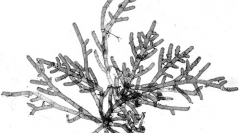

 Cryptogamie, Algologie
28 (4) - Pages 337-351
Cryptogamie, Algologie
28 (4) - Pages 337-351The marine green alga Boodlea vanbosseae is widely distributed in the tropical Indo-West Pacific region. The phylogenetic position of this somewhat unusual member of the genus is assessed based on morphological examination and phylogenetic analysis of nuclear-encoded partial large subunit rDNA sequences. Boodlea vanbosseae differs from other species of the genus by its coarse, irregularly branching filaments, the typical rhizoids developing from the proximal or apical poles of cells and the absence of calcium oxalate crystalline cell inclusions. These apparent morphological differences are confirmed by the molecular data, which reveal that B. vanbosseae is distantly related to other species of Boodlea (B. composita and B. montagnei), but instead clusters in another siphonocladalean clade that includes Anadyomene, Microdictyon, Cladophora liebetruthii and C. catenata. Within this clade, B. vanbosseae is most closely related to C. catenata, with which it shares several morphological features, such as a cushion-like habit composed of coarse filaments, and the presence of similar rhizoidal cells with terminal haptera. At this stage we restrain ourselves from making taxonomic changes because previous molecular phylogenetic studies have demonstrated that a complete rearrangement of the classification in the Siphonocladales and Cladophorales is inevitable. Remarkably, the cells in both taxa are infected by marine, ascomycotan fungi, which grow either on the distal face of the cross walls in B. vanbosseae, or on the longitudinal cell wall in C. catenata.